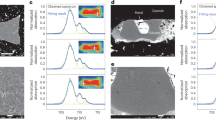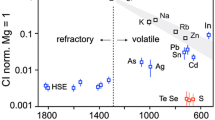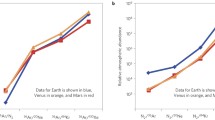Abstract
Knowledge of the oxidation state of the Earth's mantle is critical for understanding the processes of magma genesis and the composition of deep-seated volatiles. Measurements reported here of the intrinsic oxygen fugacities (s) of mantle-derived spinels from peridotite and megacryst assemblages show that the Earth's upper mantle is close to the synthetic iron-wustite (IW) buffer curve in versus T space. It seems likely that most erupted volcanics are oxidized after their formation, perhaps by diffusive H2 loss1. There is a strong possibility that the mantle was in equilibrium with a core-forming metal phase, and that subsequent oxidation of the upper mantle resulted from an interaction between the present oxidizing atmosphere–hydrosphere and the mantle by subduction processes. Evidence in support of this mechanism has been supplied by rare-gas analyses of deep-seated nodules from kimberlites2.
Similar content being viewed by others
References
Sato, M. Geophys. Res. Lett. 5, 447–449 (1978).
Kaneoka, I., Takaoka, N. & Aoki, K.-I. Earth planet. Sci. Lett. 36, 181–186 (1978).
Ringwood, A. E. The Origin of the Earth and Moon (Springer, New York, 1979).
Johnson, F. S. Space Sci. Rev. 9, 303–324 (1969).
Levine, J. S. in Comparative Planetology (ed. Ponnamperuma, C.) 165–182 (Academic, New York, 1978).
Walker, J. C. G. Evolution of the Atmosphere (Macmillan, New York, 1977).
Haggerty, S. E. Geophys. Res. Lett. 5, 443–446 (1978).
Bence, A. E., Grove, T. L. & Papike, J. J. Precamb. Res. 10, 249–279 (1980).
Sato, M. Geol. Soc. Am. Mem. 135, 289–307 (1972).
Arculus, R. J. & Delano, J. W. Lunar planet. Sci. 11, 28–30 (1980).
Arculus, R. J. & Delano, J. W. Geochim. cosmochim. Acta (in the press).
Ulmer, G. C., Rosenhauer, M. & Woermann, E. Trans. Am. Geophys. Un. 61, 413 (1980).
Flynn, R. T., Ulmer, G. C. & Sutphen, C. F. J. Petrol. 19, 136–152 (1978).
Snethlage, R. & Klemm, D. D. Contr. Miner. Petrol. 67, 127–138 (1978).
Binns, R. A., Duggan, M. B. & Wilkinson, J. F. G. Am. J. Sci. 269, 132–168 (1970).
Evans, S. H. Jr & Nash, W. P. Am. Miner. 64, 249–267 (1979).
Frey, F. A., Green, D. H. & Roy, S. D. J. Petrol. 19, 463–513 (1978).
Jagoutz, E. et al. Proc. 10th Lunar planet. Sci. Conf, 2031–2050 (1979).
Haggerty, S. E. Miner. Soc. Am. Short Course 3, Hg 101–277 (1976).
Boettcher, A. L. & O'Neil, J. R. Am. J. Sci. (in the press).
Menzies, M. & Murthy, V. R. Earth planet. Sci. Lett. 46, 323–334 (1980).
Ulmer, G. C. et al. Am. Miner. 61, 653–660 (1976).
Ringwood, A. E. Geochem. J. 11, 111–135 (1977).
Murthy, R. V. & Hall, H. Phys. Earth planet. Inter. 2, 276–282.
Ringwood, A. E. Geochim. cosmochim. Acta 15, 195–212 (1958).
Mao, H.-K. Yb. Carnegie Instn Wash. 73, 510–518 (1974).
DePaolo, D. J. & Wasserburg, G. J. Geophys. Res. Lett. 4, 465–468 (1977).
Taylor, S. R., Johnson, R. W., Arculus, R. J. & Perfit, M. R. Basaltic Volcanism, Ch. 1 (NASA, in the press).
Arculus, R. J. Tectonophysics (in the press).
Wyllie, P. J. Tectonophysics 17, 189–209 (1971).
Wyllie, P. J. in Energetics of Geological Processes (eds Saxena, S. K. & Bhattacharji, S.) 389–433 (Springer, New York, 1977).
Rubey, W. W. Bull. geol. Soc. Am. 62, 1111–1147 (1951).
Holland, H. D. in Petrologic Studies: A Volume in Honor of A. F. Buddington (eds Engle, A. E. J., James, H. L. & Leonard, B. F) 447–477 (Geological Society of America, New York, 1962).
Arculus, R. J. & Delano, J. W. Geochim. cosmochim. Acta (submitted).
Chou, C.-L. Proc. 9th Lunar planet. Sci. Conf. 219–230 (1978).
French, B. M. Rev. Geophys. 4, 223–253 (1966).
Heald, E. F. Am. J. Sci. 266, 389–401 (1968).
Karzhavin, V. K. & Vendillo, V. P. Geochim. Int. 7, 797–803 (1970).
Hunten, D. M. J. atmos. Sci. 30, 1481–1494 (1973).
Miller, S. L. & Urey, H. C. Science 130, 245–251 (1959).
O'Hara, M. J. Scott. J. Geol. 1, 19–40 (1965).
Author information
Authors and Affiliations
Rights and permissions
About this article
Cite this article
Arculus, R., Delano, J. Implications for the primitive atmosphere of the oxidation state of Earth's upper mantle. Nature 288, 72–74 (1980). https://doi.org/10.1038/288072a0
Received:
Accepted:
Issue Date:
DOI: https://doi.org/10.1038/288072a0
- Springer Nature Limited
This article is cited by
-
A hydrothermally precipitated catalytic iron sulphide membrane as a first step toward life
Journal of Molecular Evolution (1994)
-
Oxygen fugacity constraints on the southern African lithosphere
Contributions to Mineralogy and Petrology (1991)
-
Magnetite activities across the MgAl2O4-Fe3O4 spinel join, with application to thermobarometric estimates of upper mantle oxygen fugacity
Contributions to Mineralogy and Petrology (1988)
-
Upper mantle oxygen fugacity recorded by spinel lherzolites
Nature (1986)
-
CO2-CO fluid inclusions in a composite peridotite xenolith: implications for upper mantle oxygen fugacity
Contributions to Mineralogy and Petrology (1984)





